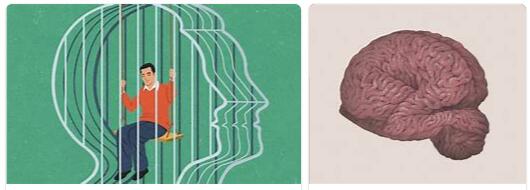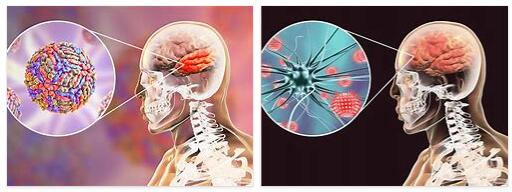The asomatognosia affect the perception of the body. Patients feel that a section of their own body no longer belongs because of lesions in the parietal lobe. Because of the lack of understanding of the disease, treatment is considered difficult.
What is asomatognosia?
Medicine understands asomatognosia to be a lack of ability to perceive one’s own body parts, which is based on a physical cause. Literally translated, the term means “not knowing” about one’s own body. Most of the time, the patients simply have no feeling for the belonging of their own body parts. Often, patients can no longer perceive diseases of the extremities concerned due to the lack of a sense of belonging.
Asomatognosias affect either one or both sides of the body. Most often the left side of the body is affected, as a lesion of the right parietal lobe is considered to be the most common cause of the appearance. There are different types of asomatognosia. In addition to allesthesia and anosognosia, the most widespread forms include anosodiaphoria, asymbolia, autotopagnosia and pain symboly.
Asomatognosia is usually accompanied by further neurological deficits. As a rule, the symptoms do not appear in isolation, but rather as part of an entire syndrome and can also affect extremely localized areas of the body.
Causes
Asomatognosia is usually preceded by right hemisphere lesions of the parietal lobe. The so-called Brodmann areas are located in the parietal lobe. This area of the brain plays a role in the combination of sensory information from the individual sensory channels and is thus involved in both spatial perception and body navigation through space. The parietal flap is used primarily for orientation, determines the surroundings and incorporates the images of the surroundings into a motor strategy.
The most common cause of lesions in this area of the brain is a cerebral infarction. Bleeding from the middle cerebral artery can also trigger the symptoms. The corresponding sections of the parietal lobe can also be damaged by inflammation. However, causal cerebral infarction and bleeding are more common.
The least common are causative cysts or tumors in the parietal lobe area. In particular, asomatognosia due to bleeding and cerebral infarction can cause entire syndromes such as Anton syndrome, in which the patient cannot recognize his own blindness due to the brain lesions. Some asomatognosias are localized in the frontal lobe instead of in the parietal lobe or, in the case of Anton’s syndrome, directly in the visual pathways.
Symptoms, ailments & signs
As a form of asomatognosia, the pain symbolism manifests itself in a locally lacking pain perception, which impairs the understanding of the triggering pain. The pain is felt, but due to the lack of understanding of its biological significance, no appropriate defense reactions take place.
In autotopagnosia, the patient can no longer locate or name their own body parts. Asymbolia due to lesions in Brodmann areas 5 and 7, on the other hand, impairs the general understanding of all the representational signs.
Allesthesia does not allow the patient to assign stimuli to the correct parts of the body. Two special forms of asomatognosia are anosognosia and anosodiaphoria. With anosognosia the patient cannot perceive his own body deficits and the anosodiaphoria makes him feel indifferent to his own illness.
Symptoms can overlap or associate with other neurological symptoms, such as paralysis, deafness, or blindness. Also vertigo refers to lesions in the lower parietal lobe. Lesions in the lateral parietal lobe are often associated with speech disorders.
Diagnosis & course
The diagnosis of asomatognosia is primarily made through medical history, psychiatric assessment, and brain imaging. This phenomenon is often an incidental finding because patients do not see a doctor because of a disease they are completely unaware of.
In Anton syndrome, for example, those affected do not appear to the doctor because of the blindness that has occurred, but because of accompanying neurological symptoms. When their blindness is revealed to them, they deny the disease because they feel they can still see. The course of asomatognosia depends on the cause and when the diagnosis and treatment are made.
Complications
As a rule, asomatognosia results in a greatly reduced perception of pain. The patient cannot decide for himself whether certain parts of the body are in pain or not. This increases the risk of illness and accidents. The biological defense reactions are also limited, since the pain sensation is no longer active.
In some cases, the stimuli are also not assigned to the right places on the body. This means that pain can be felt in the wrong places and lead to wrong conclusions. In many cases, patients also suffer from hearing loss and vision problems. It is not uncommon for those affected to experience difficulties speaking and paralysis in certain parts of the body.
In most cases, psychological treatment is sought for asomatognosia. However, this can take several months, as it is often not easy to convince the patient of a certain disease. As a rule, it cannot be predicted whether further complications will arise.
If the asomatognosia is not treated, cancers and cysts develop in many cases. Those affected also suffer from an increased risk of accidents. As a rule, life expectancy decreases with asomatognosia.
When should you go to the doctor?
In many cases, asomatognosia is diagnosed in children. Above all, the parents must inform the doctor about the disease so that he can make a diagnosis. As a rule, a doctor should be consulted if the person concerned is no longer able to feel pain properly.
Pain can be perceived either too strongly or too weakly. Especially in children, asomatognosia can lead to development disorders and growth disorders. It is not uncommon for language disorders to occur.
A doctor must then be consulted if the patient complains of paralysis or other disorders of sensitivity. It is not uncommon for blindness or deafness to occur. Spinning vertigo can also be a symptom of asomatognosia and must be examined by a doctor. As a rule, the first examination and diagnosis is carried out by the general practitioner. The individual symptoms and complaints are treated by a specialist, although a full treatment cannot be carried out in most cases.
Treatment & Therapy
The treatment of asomatognosia proves difficult. Since those affected often have no insight into the disease and therefore cannot understand it from their own experience, they often refuse treatment and sometimes even react aggressively and aggressively to the diagnosis of asomatognosia. Understanding the disease is the first starting point for treatment. As a rule, this requires psychotherapeutic intervention in which the patient is regularly reminded of the deficit.
Untreated asomatognosia can lead to neurological deterioration, depending on the cause of the disease. Such deteriorations particularly affect the causal masses such as cysts and tumors. If the patient with asomatognosia no longer perceives one half of the body as belonging, this also harbors a high risk of injury for the affected side of the body. Only an early insight into the deficits can prevent consequential injuries.
The further treatment of asomatognosia takes place after understanding the disease, depending on the respective cause. Cysts and tumors must be surgically removed. In the case of bleeding, it is important to prevent repetitions. Special therapies are available for syndromes such as Anton syndrome. The cortical blindness of this disease can now be largely reversed through targeted light pulses, provided that treatment is carried out quickly.
Outlook & forecast
The prognosis for asomatognosia is not very optimistic. The patient’s lack of insight into the disease often makes treatment or medical care impossible. The patient’s consent is required for treatment to be initiated. This is rarely available due to a lack of insight or is withdrawn shortly after the start of treatment.
To change the situation, participation in psychotherapy is recommended. Only a few patients agree with this as they do not perceive any feeling of illness. If consent is given due to the influence of a guardian, strong resistance from the patient can be expected.
This leads to long delays or a counterproductive result. Without treatment, an increase in asomatognosia is to be expected. The disease progresses and there are more symptoms. In severe cases, irreparable damage occurs.
In the best-case scenario, the patient agrees to the treatment and actively participates in the healing process. Here the improvement depends on the physical cause. However, a complete cure is still questionable. In the case of a tumor, an operation must be carried out. The subsequent therapy and the nature of the tumor are decisive for a possible healing. There are ways to alleviate bleeding. Nevertheless, there is also the risk of a fatal course of the disease.
Prevention
Asomatognosia itself cannot be prevented directly. Causal diseases such as tumors or strokes can be prevented to a certain extent through a healthy lifestyle and regular check-ups.
Aftercare
In most cases, there are no follow-up options available to those affected with asomatognosia. The disease cannot be treated completely either, as it is still largely unexplored so that only a purely symptomatic treatment can take place. However, therapy with the help of a psychologist can alleviate the symptoms of asomatognosia, so that this is recommended to the person concerned.
An early diagnosis and treatment of asomatognosia also has a positive effect on the further course of the disease and can prevent possible complications. In some cases, tumors can also be responsible for the asomatognosia. These have to be removed by a surgical procedure.
After such an operation, the patient needs to rest and take care of his body. In doing so, unnecessary exertion and sporting activities should be avoided. Furthermore, regular examinations are also useful in order to avoid the recurrence of tumors.
The loving care and support of the patient by friends and family also makes sense and can make life much easier for the person affected. In some cases, contact with other patients with asomatognosia can also be helpful, as this can lead to an exchange of information.
You can do that yourself
Anyone who suffers from asomatognosia has no way of combating the cause of the disease through self-help measures. To make matters worse, most of those affected lack insight into their suffering. In this case, it is up to the family member to take appropriate measures to get the patient to seek therapy and to organize everyday life in such a way that the risk of accidents is minimized.
Patients who do not understand should be made aware of their suffering in a sensitive but consistent manner by those around them. If the asomatognosia leads to an affected person leaving one half of the body or certain parts of the body neglected, this can be done relatively easily. In these cases, the patient should be photographed and confronted with the photos immediately.
The state of partial neglect can then no longer simply be rationalized away. The method is also helpful when parts of the body that are not perceived show clearly visible injuries, especially blue-black discolored hematomas. Constant confrontations of this kind can lead to the patient finally realizing their suffering and consenting to treatment.
Since the person concerned does not perceive injuries himself or does not correctly assign pain, relatives must regularly examine the person concerned physically. Otherwise there is a risk that fractures, especially those of the hands or feet, remain undetected and the bones grow together crookedly.
Pointed-edged furniture and other objects that are associated with an increased risk of accidents should be removed from the apartment.



